Hi all, I just found the forum and I love the community here, this is my first post please let me know if I am doing anything wrong.
I wanted to share the progress on my CB360 build, first some information:
Body:
- 1974 CB360 frame
- upgraded front disk break
- 1999 Yamaha FZR600R swingarm (to fit the larger rear wheel and slightly lengthen the bike)
- All the lights / wiring / switches are new with custom fused 12v system
- Custom carbon fiber seat pan with faux leather upholstery
- Lots of small 3d printed parts / brackets
Powertrain:
- 12kW 17" QS motor
- Kelly KLS 96601-8080H controller
- 400A contactor / fuse system with pre-charge bypass
I haven't built the battery yet, I have designed several packs using different cells but have not decided on a final design. Firstly the constraints:
- Size, I would like to not have to modify the structural parts of the frame, which gives me approx. 15" x 15" x unbounded. (not square, see pictures)
- Voltage, I am aiming for 96-120V battery, with a nominal voltage >96V and fully charged max at 120V.
- Cost, budget build I would like to keep the battery under $1500 w/ BMS and charger.
- Capacity, I want the bike to be a city commuter, I don't need it to have crazy range I want a minimum of 40 miles range with conservative driving (no 0-100 pulls).
- Current, this is where I need your help the most, I have done lots of reading here and across the internet, and I am a little confused on how much current I should design my battery to supply. I would like to be able to supply as much current is necessary to give the bike good acceleration and top speed. Kelly's manual rates the KLS96601-8080H at 600A peak (30 seconds) and 240A continuous. I think I have gathered from this forum that that is phase amps, and that that exceeds what is necessary for the motor? The manual also says the controller can do "current multiplication" where by reducing voltage it can increase current. How much current does my battery need to supply?
I have looked at lots of different cells (mostly battery hookup) SPIM08HP / Headway / LiFePo4 Prismatic / NMC ... and more. Right now I am looking at these BMW NMC packs because with 3 of them, reconfigured to 30s I will get approx. 45ah 115V but they are rated to only supply 75A continuous and 300A peak, is that enough? I hope you guys can give me some insight here.
Anyways here's some pictures:
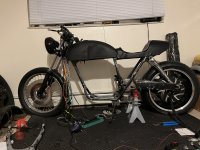
Old picture good profile view
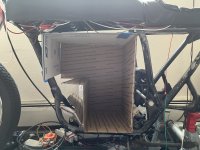
Cardboard mock up of 3x BMW packs like described above
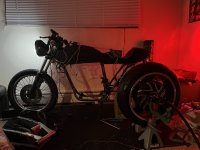
Old pic from testing lights
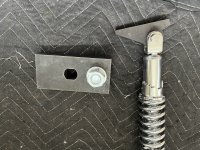
Some laser cut steel parts (left is to fit swingarm to wheel, and right is to fit rear suspension to swingarm)
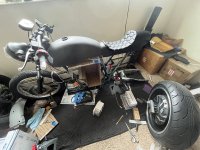
Slightly newer pic of the build (pls ignore mess)
Excited to hear your thoughts!
I wanted to share the progress on my CB360 build, first some information:
Body:
- 1974 CB360 frame
- upgraded front disk break
- 1999 Yamaha FZR600R swingarm (to fit the larger rear wheel and slightly lengthen the bike)
- All the lights / wiring / switches are new with custom fused 12v system
- Custom carbon fiber seat pan with faux leather upholstery
- Lots of small 3d printed parts / brackets
Powertrain:
- 12kW 17" QS motor
- Kelly KLS 96601-8080H controller
- 400A contactor / fuse system with pre-charge bypass
I haven't built the battery yet, I have designed several packs using different cells but have not decided on a final design. Firstly the constraints:
- Size, I would like to not have to modify the structural parts of the frame, which gives me approx. 15" x 15" x unbounded. (not square, see pictures)
- Voltage, I am aiming for 96-120V battery, with a nominal voltage >96V and fully charged max at 120V.
- Cost, budget build I would like to keep the battery under $1500 w/ BMS and charger.
- Capacity, I want the bike to be a city commuter, I don't need it to have crazy range I want a minimum of 40 miles range with conservative driving (no 0-100 pulls).
- Current, this is where I need your help the most, I have done lots of reading here and across the internet, and I am a little confused on how much current I should design my battery to supply. I would like to be able to supply as much current is necessary to give the bike good acceleration and top speed. Kelly's manual rates the KLS96601-8080H at 600A peak (30 seconds) and 240A continuous. I think I have gathered from this forum that that is phase amps, and that that exceeds what is necessary for the motor? The manual also says the controller can do "current multiplication" where by reducing voltage it can increase current. How much current does my battery need to supply?
I have looked at lots of different cells (mostly battery hookup) SPIM08HP / Headway / LiFePo4 Prismatic / NMC ... and more. Right now I am looking at these BMW NMC packs because with 3 of them, reconfigured to 30s I will get approx. 45ah 115V but they are rated to only supply 75A continuous and 300A peak, is that enough? I hope you guys can give me some insight here.
Anyways here's some pictures:

Old picture good profile view

Cardboard mock up of 3x BMW packs like described above

Old pic from testing lights

Some laser cut steel parts (left is to fit swingarm to wheel, and right is to fit rear suspension to swingarm)

Slightly newer pic of the build (pls ignore mess)
Excited to hear your thoughts!

